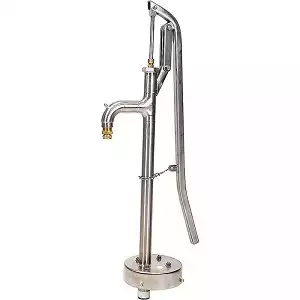Knowing you’ve got water available but can’t access it is incredibly frustrating, but if the power goes down, that’s the situation many homesteaders and off-gridders find themselves in.
We installed a hand pump alongside our submersible electric pump a few years back and now have reliable access to water even when no grid power or solar electricity is available.
Pitcher pumps are simple devices that are easy to install, whereas a deep well pump will require a few more tools and a little more technical expertise.
Most shallow well pumps are situated inside the house for convenience; a different approach is required to install a deep well hand pump, which is usually close to the water source.
The most critical thing to know before you even buy a pump, let alone install one, is how deep the water is below the ground. A traditional suction pump can retrieve water from a well of less than 20′, but a different model is required for deeper wells.
How To Measure The Depth Of Your Well
- Tie a weight to a long line of cord or twine
- Lower the weight into the well until you hear it hit the water
- Make a knot in the cord to mark the depth and retrieve the weight
- Your well is as deep as the length of the cord from the weight to the knot
For deep well hand pump installations, you’ll also need the following measurements:
- Well casing height
- Well casing diameter, both inside and out
How To Install A Shallow Well Hand Pump
#1. Follow the manufacturer’s instructions on securing the pump head to the counter. This will involve drilling a hole for the wellhead pipe and, for most models, four additional holes to screw the base of the pump securely into position.
#2. Once the base is secured, it’s time to install the pump cylinder. On a Bison pump, this involves lifting the pump handle to its furthest point on the wellhead while simultaneously pulling the stainless steel rod up the cylinder as far as it will go.
#3. Now connect the lift rod from the pump head to the one from the pump cylinder and tighten the nuts and coupling.
#4. Before screwing the cylinder into place, put sealant tape around the male thread of the wellhead. Now push the pump cylinder up until it meets the bottom of the wellhead, and use both hands to screw it into position.
#5. Connect the suction line to the check valve at the base of the cylinder, ensuring it’s long enough to reach your shallow well or cistern.
#6. Before submerging the pipe, wrap the foot valve in a fine mesh nylon screen to prevent sediment from entering and blocking the valve.
#7. Pop the foot valve and pipe into your well, making sure the foot valve is suspended four feet above the bottom of the well.
A couple of quick pumps and, you can reward your efforts with a glass of cold fresh water.
If you prefer visual instructions, press play on the video below.
How To Install A Hand Pump For a Deep Well
Positioning is crucial when it comes to installing a deep-well hand pump. Too low down, and you’ll be operating it at an uncomfortable angle and unable to fit a bucket between the pump head and the ground. Too high, and you won’t get the pressure required to achieve a decent flow rate.
A cement foundation is the best for a deep well hand pump as it’s sturdy and keeps the pump level. Once this is in place, you can start assembling the pump.
#1. Attach the first piece of the sucker rod, inside the PVC pipe, to the rod protruding from the bottom of the cylinder head. To do this, pull the cylinder rod up to the top and then screw the next piece of rod into place, using pliers to secure the join.
#2. Continue adding pieces of the rod until you achieve the desired length, using a pair of vice grips to hold it in place while you tighten the lock nuts and secure the coupling.
#3. Once your rod is assembled, attach the male end of the PVC piping to the head of the pump cylinder, using two hands to tighten.
#4. Turn the power off before continuing if you’re installing the hand pump alongside an existing electric submersible pump.
#5. Remove the cap from your well casing
#6. Attach a safety rope to the pump cylinder and tie it to the well casing
#7. Lower the cylinder and first length of pipe into the well. Some pumps, like those from Bison, come with a special tool known as a paddle, which slots around the widened end of the PVC pipe, holding it in place above the well casing while you attach the additional piping.
#8. Pull the rod up through the PVC pipe and hold it in place with a vice grip.
#9. Attach the next length of pipe and rod to the length already inserted into the well casing.
#10. Before you lower the last section of piping into the well, you need to drill a breathe hole roughly 1/8″ from the end to ensure water doesn’t stay in the pipe and freeze over winter.
#11. Once all the pipe and rod have been fed into the well, it’s time for the piece de resistance – the pump head!
#12. Remove the shoulder bolt from the top of the pump handle, and then find another person to assist you with the next step.
#13. Attach the pump head to the rod protruding from the top of the well and tighten the jam nut.
#14. Lower the pump head onto the PVC pipe, making sure someone’s holding it so it doesn’t get pushed down into the well.
#15. Turn the pump head clockwise to screw it into the top of the PVC pipe.
#16. Tie the safety rope onto the eye bolts underneath the well cap in the base of the pump head.
#17. While one person takes the weight of the pump head, the other pushes the rope into the casing
#18. Lower the pump head down onto the top of the well casing and tighten the bolts to secure it in position.
#19. Reattach the top of the pump handle to the lift rod without overtightening, as this will prevent the handle from moving.
#20. Tighten the nuts on the top of the base of the pump head. This will secure the gasket inside the top of the well casing.
#21. If the pump comes with a cap on the end of the spout, remove this cap before pumping.
#22. Give the handle a few pumps and experience the joy of getting a thirst-quenching drink of water pumped by your own hand.
If you prefer visual instructions, press play on the video below.
Pump Supplier
The pump mentioned in the video can be purchased at Lehmans – see details below. (Note it is expensive – starting at $1800)
 Bison Stainless Steel Deep Well Pump
Bison Stainless Steel Deep Well Pump
This self-priming pump can pump up to five gallons per minute from depths of 300 feet deep, making it suitable for emergency and everyday use.
Related
Check out our other related posts for more information:
- Types of well pumps
- Best solar well pumps
- Best hand pumps for wells (shallow and deep well options)
- How to install a shallow well jet pump (powered)
- How to get water from a well without electricity
Conclusion
Not every hand pump has the same components, so the installation process may vary from model to model. There are many helpful video tutorials to guide you through installing the most popular makes of hand pumps. I’d also recommend reading the installation manual!
While the installation process is pretty straightforward, a deep well hand pump is very much a two-person job, so don’t embark on it without having an extra pair of hands nearby.
Before installing a hand pump, ensure you’ve got all the materials and tools you require to make the process as streamlined as possible. Take your time with the installation – a rushed job will only lead to more headaches and maintenance issues further down the line.
If you’re not confident that your DIY skills are up to the task, consider paying a pump professional to do the installation for you or ask a knowledgeable friend for help.
You may not want to pump water by hand every day, but having the option available could be a lifesaver in a power outage or natural disaster.



Where do I order this Bison deep well hand pump with all the necessary lengths of plastic piping?
It can be bought at Lehamns – I have added the link above in the article.
Roughly how much did this hand pump cost you? I was on the Bison pumps website and you have to request a quote. I know the price will differ based on the well casing size and the static water level depth, but just want to know a rough ball park. Hundreds of dollars or thousands?
It will be at least $2000 for all the necessary components – check out the link to Lehmans in the article for an exact price.
Where do I buy the deep well pumping system i see in the video?
It can be found at Lehmans – link is now in the article .